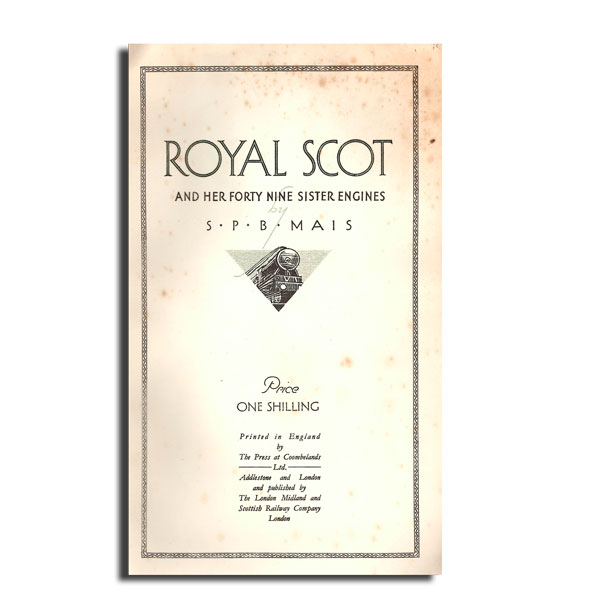Description
This is a most unusual book, rather spoiled by being cheaply produced. I am not aware of any other publication by a railway company, listing all the named locomotives in a class, and explaining the origins of the names. Perhaps the Southern should have done the same for the “King Arthurs”, giving a “Who’s Who” of some of the more obscure knights in that class, or the LNER listed the races won by its famous race horse “Pacifics”?
By 1927, the locomotive department of the LMS was in crisis, thanks to the premature death of C.J. Bowen Cook, the refusal of George Hughes, the company’s first CME to take early retirement, and his insistence on making his HQ at Horwich, remote from the intrigues of the former Midland dominated traffic department, and the Board clinging to “Buggins turn” in making some appointments. The result was the appointment of Sir Henry Fowler, a first class organizer and production engineer, who had been borrowed by the Government to run the Royal Aircraft Establishment at Farnborough during the Great War, to be CME. Fowler freely admitted later in life that he had never designed a locomotive, which placed him at a disadvantage, in the feud which had existed on the Midland between mechanical engineering and the traffic department, ever since the days of Deeley and Paget. The Traffic Dept. wanted small engines, on lightly loaded trains running at frequent intervals. If a train was heavier than normal, then put two locomotives on it. Expensive in terms of footplate crew. The same principle applied to freight, resulting in the spectacle of underpowered 0-6-0s double-headed by elegant Johnson “Spinners” having to work the heavy coal trains between Toton and Brent because the capacity of the line had been reached. Consequently “Traffic” turned a deaf ear to suggestions of larger locomotives, and ordered repeats of designs more than a decade out of date – the 4-4-0 compounds, which were quite inadequate to deal with the post Great War changes of heavier trains and shorter working hours for drivers.
There were three classes of locomotives inherited from the pre-group companies which although good, had their faults and were capable of improvement. These were the Hughes L&Y 4 cylinder 4-6-0s and the Bowen Cooke “Prince of Wales” and “Claughton” classes of the same wheel arrangement. The demands of War, and the upheavals afterwards prevented this work being done, although Hewitt Beames, Cooke’s successor at Crewe, had made a good start by modernizing some “Princes” and fitting them with Caprotti valve gear. “Claughtons” were much improved by bigger boilers. Derby turned a deaf ear, and faced with panic setting in at the prospect of the heavy summer traffic, persuaded the Board to take the disgraceful step of going behind Fowler’s back and asking the Great Western if they would sell the LMS 40 “Castle” class 4-6-0s.
This was of dubious legality. For many years, British railway companies had been prohibited from making rolling stock for sale, and while this condition had been waived under stress of War, there is no doubt that the Locomotive and Allied Manufacturer’s Association would have gone to court to seek an injunction had the deal been publicized. A request for a set of “Castle” class drawings was likewise declined. Only at this stage was Fowler brought into the picture, and Richard Maunsell of the Southern was asked for a set of “Lord Nelson” class 4- cylinder 4-6-0 drawings. A specification was drawn up, based on these but for a 3 cylinder machine, incorporating as many LMS Derby components as possible, and sent to the North British Locomotive Co. This firm rose to the challenge, and in a remarkably short space of time, produced the 40 “Royal Scot” locomotives celebrated here. At last the LMS had a modern locomotive to be proud of. They were far from perfect, weak features included those Derby items which had been insisted upon, and they did not reach their full potential until rebuilt with taper boilers by William Stanier… but that is another story!
They were named after British Military units, and early locomotives which had run on predecessors of the LMS, each nameplate including a regimental crest, or line drawing of the loco as appropriate. With a growing appreciation of the publicity value of special naming ceremonies, the locos were gradually renamed after other “military” formations although “The Girl Guide” and “The Boy Scout” were perhaps pushing things a bit far. However this last did at least cause LMS officials the opportunity of maintaining very straight faces, when Sir Henry Fowler, a dedicated Scout Master in his spare time, turned up at the naming ceremony in a pointed hat, shorts and freshly polished Woggle!
Stuart Petre Brodie “SPB” Mais (1885–1975) was a prolific British author, journalist and broadcaster, who is credited with having written over 200 books, many of which concerned the English countryside. His forte was of the “Hiking in Hertfordshire,” “Rambles in Epping Forest” genre, many of which were commissioned by railway companies to encourage day trip travel. He seems a little outside his comfort zone writing about railway locomotives, and keen eyed readers will notice some elementary errors. Apparently throughout his life only a few steps ahead of creditors for some reason, he could probably not afford to turn down the offer of this job, even though it would have involved him in many hours researching Regimental Histories.
This is a very interesting and unusual book.

Reviews
There are no reviews yet.